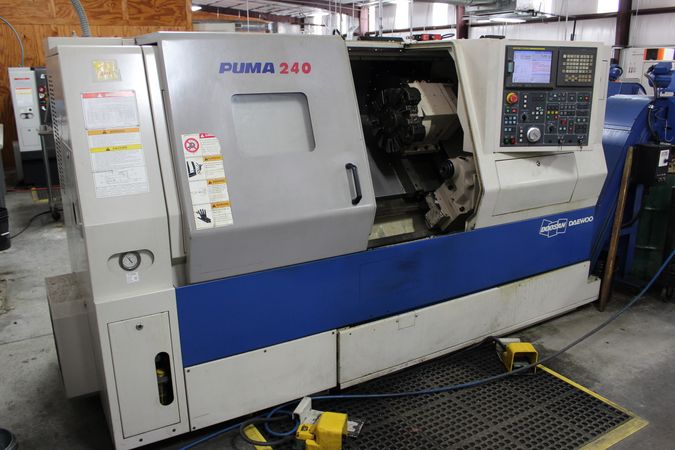Ok, so a real cnc, a Puma 240 ,no idiot controls (IC’s) that give you just enough knowledge to trash stuff or get yourself hurt. Actual controls that let you tell the thing what you want rather than let the IC do what it thinks you want. Not huge machines but very capable and good power to let you take more than 2mm deep cuts.

This one is a Daewoo Puma 240 with a 21i-TB Fanuc controller, second hand? somewhere in the £12 to £15k range for a decent one. A quick run down of what you are looking at. Other versions are available, bigger and smaller at surprisingly around the same price!
It’s a “slant bed” meaning the bedway is at a 45 degree angle, this allows chips and swarf to fall directly onto the internal conveyor to be dumped in the bin at the right hand side with no user intervention. It also means that bigger diameter pieces can be cut without having to remove sections of the bed to get them in.
Mounted on that bed is the turret type tool holder that has 12 possible positions for tools to be mounted, either internal or external tools. Each tool has it’s own “Offset” that relates to the position of the machines 0 – 0 position. These positions don’t change unless you change the tool so no need to set them for every job. As they are mounted all the time you don’t get accuracy problems when changing tools like you do with a manual or Colchester “type” holder. Another ironic feature of these turrets is external cutting tools can be mounted to cut with the spindle running clockwise OR anti clockwise so no need to buy left and right hand biased tools.
On the same bed is a hydraulic powered tailstock, the position can be set in a couple of ways, you can program the entire tailstock to move or you can program just the quill to move in or out. The pressure used by the tailstock is set with a dial to the right hand side of the machine before starting.
Two big yellow foot switches? the left hand one opens and closes the hydraulic chuck manually, the right hand one moves the tailstock quill manually with a touch from the feet. NEITHER pedal is active when the machine is running so no danger of a moron hitting it and the workpieces falling out at speed.
Bottom left is the oil reserve that keeps the slideways lubricated when the machine is powered up, above that is a dial gauge that allows setting of the pressure used by the chuck everywhere from “A light finger pressure” to “crush everything flat for shits and giggles” level. A safety function means the spindle cannot start unless the chuck feeds back that it is clamped at a safe working level. In “theory” this means you shouldn’t have anything getting ripped out of the chuck by it not being tight enough.
Usual door interlocks (and on something that moves very quickly you dam sure better use them), that turret will get to your arm or hand and pull you in before you can react. Had a young lad get pulled in to a CNC lathe in my last place, don’t fancy seeing it again, he was lucky, it only broke both his arms.
Takes 68mm diameter up the spindle and is “Bar fed” capable (if required you can build your own, there is no need to buy bar feeds) Gear range can be selected manually (to fix the gear) OR you can let the machine decide on the most powerful range with no loss of torque at higher speeds.
Ok so the big box of magic buttons, buttons are good, lots of buttons are better, it means we can look super clever by randomly banging buttons and the boss thinks we are “great engineers” when in reality the average 12 year old could program one of these. That’s going to need another page so hit the menu and off you go to have an explanation.
A lot more on buying machines and where to get them along with what’s currently on the market is coming soon (*see earlier comment about the amount of time I need and the amount of time I have)